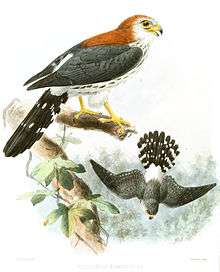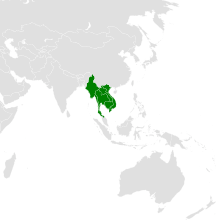White-rumped falcon
The white-rumped falcon (Polihierax insignis) is a species of bird of prey in the family Falconidae native to Indochina. It is sometimes placed in its own monotypic genus, Neohierax.
| White-rumped falcon | |
|---|---|
 | |
| Scientific classification | |
| Kingdom: | Animalia |
| Phylum: | Chordata |
| Class: | Aves |
| Order: | Falconiformes |
| Family: | Falconidae |
| Genus: | Polihierax |
| Species: | P. insignis |
| Binomial name | |
| Polihierax insignis Walden, 1872 | |
 | |
| Synonyms | |
|
Neohierax insignis | |
Taxonomy and naming
Philip Sclater, secretary of the Zoological Society of London, presented two skins at the meeting of 7 November 1871, on behalf of the society's president Arthur Hay, Viscount Walden. A brief account of this presentation was published in 1872, becoming the first formal description of the species.[2][3]
In 1922, Harry Kirke Swann proposed a new monotypic genus for this bird, Neohierax.[4][5] During the 20th century, most taxonomic authorities retained it in Polyhierax, though Brown and Amadon supported separating the two genera. Phylogenetic analyses of morphological characteristics found the white-rumped falcon to be basal to the Falco clade, but separate from the clade containing the pygmy falcon (or African pigmy falcon, Polihierax semitorquatus) and Microhierax (falconets or pigmy falcons).[5]
Research in molecular genetics[6] has also found that the white-rumped falcon is more closely related to the Falco falcons than it is to the pygmy falcon, and indicates two major clades within the extant members of the falcon subfamily, Falconinae. Boyd places the Microhierax falconets with the pygmy falcon in tribe Polihieracini, and the white-rumped falcon as Neohierax insignis in tribe Falconini.[7]
The white-rumped falcon is also known as white-rumped pygmy falcon, white-rumped falconet, Fielden's falconet,[1] or Burmese pigmy falcon.[4]
Description
The plumage is white underneath and on the rump, with black ticking on the chest. The upper surface of the wings is dark grey. Sexually dimorphic, the female has a rufous[note 1] mantle on her upper back and behind the head, whereas in the male these areas are grey. The tail is black, barred with white.[2][4]
The shape of the tail is notably rounded, with the outermost feathers an inch shorter than the middle ones.[2] Its wings have the pointed shape typical of falcons, with the second primary feathers longest, and the first nearly equal to the third.[4][note 2]
Its legs and feet are yellow, hence the French name fauconnet à pattes jaunes (yellow-legged falconet). Base of the bill and skin surrounding the eye are yellow. Tip of the beak is grey or horn-coloured.
The wings are 145 mm (5 3⁄4 in) long, and the tail is 130 mm (5 in).[4] Modern sources give the overall length as 23–28 cm (9–11 in), weight 84–112 g (3.0–4.0 oz), and wingspan 42–49 cm (16 1⁄2–19 1⁄4 in).[8]
Its coloration is similar to the African pygmy falcon (Polihierax semitorquatus), but the white-rumped falcon is larger and proportionally longer-tailed.
Distribution and habitat
Found in Cambodia, Laos, Myanmar, Thailand, and Vietnam,[1] its natural habitats are subtropical or tropical dry forests and dry savanna. The IUCN considers it "near-threatened" by habitat loss due to logging and forest fires, and possibly hunting.[1]
Behaviour
Feeding
White-rumped falcons feed on lizards and insects, which are taken from the ground or in trees. Unlike Microhierax falconets, they do not hawk insects from the air.[5]
Breeding
This species has been little studied in the wild. It uses holes in trees for nesting, the female incubates the eggs during the day. The female lays a clutch of two white eggs, approximately 35 mm long.[5][8]
A pair have been observed to nest in a woodpecker hole, both the male and female roosting there overnight.[5]
Notes
- Described as "deep chestnut" by Walden and "bright ferruginous red" by Swann.
- Note the similarity in Swann's descriptions for the primary flight feathers of Polihierax, p. 183, Neohierax, p. 184, and Falco, p. 186.
References
- BirdLife International (2012). "Polihierax insignis". IUCN Red List of Threatened Species. 2012. Retrieved 26 November 2013.CS1 maint: ref=harv (link)
- Walden, Arthur Viscount (1872). "Notice of a new Species of Polihierax from Upper Burmah". Proceedings of the Zoological Society of London. 1871 (part 3, November 7): 627–628.
- Peterson, Alan P. (2013). "Zoonomen nomenclatural data". Retrieved 3 November 2014.
- Swann, Harry Kirke (1922). A synopsis of the Accipitres (diurnal birds of prey) : comprising species and subspecies described up to 1920, with their characters and distribution (2nd ed.). London: Wheldon & Wesley. p. 184.
- Kasorndorkbua, Chaiyan (17 February 2011). "Species account: white-rumped falcon Neohierax insignis". Global Raptor Information Network. Archived from the original on 2012-10-28. Retrieved 2 November 2014.
- Fuchs, Jérôme; Johnson, Jeff A.; Mindell, David P. (September 2014). "Rapid diversification of falcons (Aves: Falconidae) due to expansion of open habitats in the Late Miocene". Molecular Phylogenetics and Evolution. 82: 166–182. doi:10.1016/j.ympev.2014.08.010. PMID 25256056.
- Boyd, John H., III (1 October 2014). "Passerimorphae (version 2.76a)". Taxonomy in Flux Checklist. Archived from the original on 2014-10-06. Retrieved 2 November 2014.
- Clarke, W. S.; Kirwan, G. M. (2013). del Hoyo, J.; Elliott, A.; Sargatal, J.; Christie, D. A. (eds.). "White-rumped Pygmy-falcon (Polihierax insignis)". Handbook of the Birds of the World Alive. Barcelona: Lynx Editions. Retrieved 4 November 2014. alt. URL
External links
Media

- White-rumped falcon photo gallery at VIREO (Drexel University)
- "White-rumped pygmy-falcon media". Internet Bird Collection.
- Polihierax insignis in the Flickr: Field Guide Birds of the World
- Photographs at Oriental Bird Images.
- Sound recordings at xeno-canto.
Taxonomy

- "White-rumped falcon". Avibase.

- Original species description, via Biodiversity Heritage Library or Wiley.
- Neohierax original genus description.
